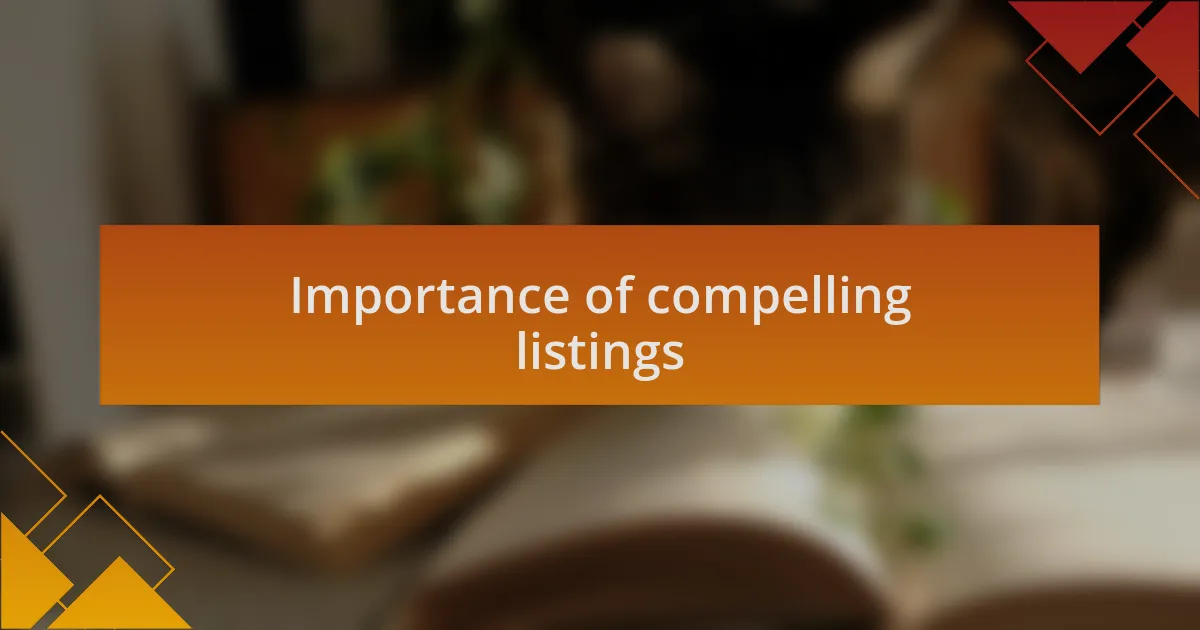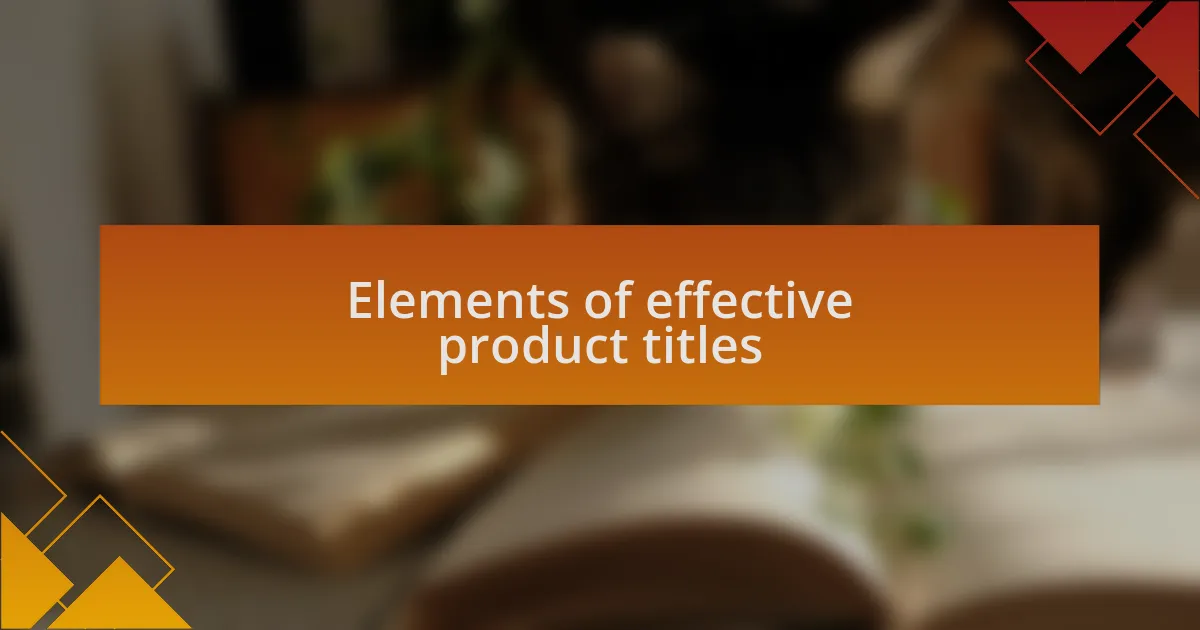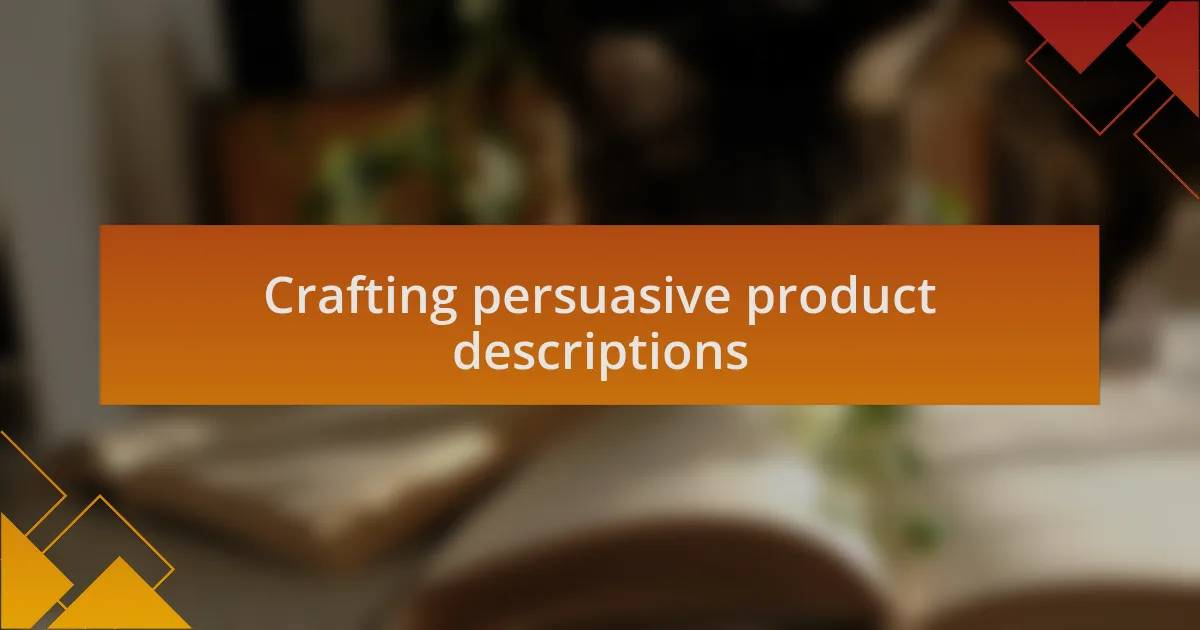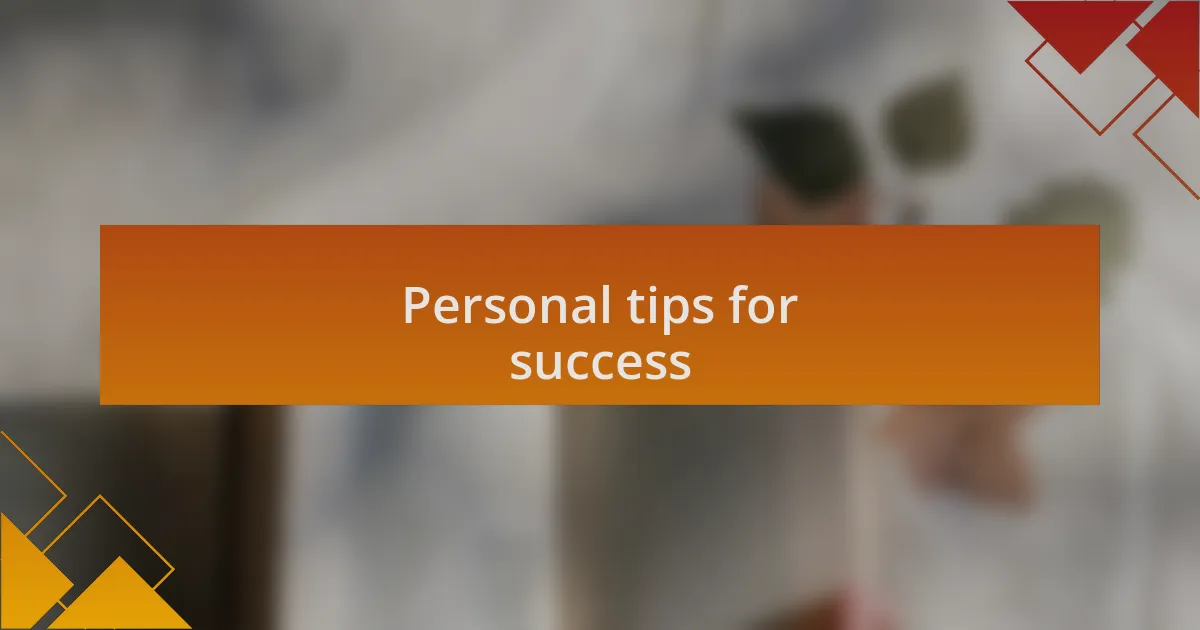Key takeaways:
- Print on demand (POD) minimizes financial risk by allowing creators to produce items only after receiving orders, enabling personalized designs based on customer feedback.
- Compelling product listings are essential, as they should tell a story and resonate emotionally with potential buyers, enhancing their desire to make a purchase.
- Effective product titles and descriptions should prioritize clarity, specificity, and emotional appeal, making them memorable and engaging to the target audience.
- High-quality, eye-catching images alongside optimized listings for search significantly improve product visibility and enhance the shopping experience for customers.

Understanding print on demand
Print on demand (POD) is a fascinating concept that has opened new avenues for creators like myself. Rather than producing large quantities of products upfront, you can design a product—be it a book, t-shirt, or mug—and have it printed only when a customer makes an order. Doesn’t that sound like a relief? I remember the stress I felt managing inventory in the past, and transitioning to POD completely transformed my approach to selling.
One of the key advantages I’ve found in using POD is the minimal financial risk involved. You don’t have to invest in a stockpile of items that may or may not sell. Instead, every piece that gets printed is a direct result of someone wanting it. This makes the process feel much more personal; it’s almost like having a direct conversation with your audience. Have you ever wished you could create something that resonated with your exact target market? POD allows you to do just that, giving you the freedom to experiment and adjust your designs based on real-time feedback.
Additionally, POD is a game-changer for independent publishers. It empowers you to bring unique stories to life without the constraints of traditional publishing. I recall feeling overwhelmed at the thought of submitting manuscripts to publishers who might not share my vision. With POD, I became the publisher, creating exactly what I wanted without compromise. This level of control is exhilarating; it invites a sense of creativity and autonomy that truly enriches the independent publishing experience.

Importance of compelling listings
Creating compelling listings is crucial in a competitive market, especially when you’re relying on print on demand. I vividly remember my early days of crafting listings that fell flat. I soon realized that a captivating product description can make all the difference; it’s not just about the item, but how you convey its value. When I finally started writing with passion and personalization, my sales began to reflect that energy.
Engaging listings do more than pique interest; they tell a story. For instance, when I described one of my books not merely as “a thrilling mystery” but as “an unforgettable journey through the shadows of human connection,” I noticed a shift. People connected with the experience I was promising, rather than just the product itself. It’s fascinating how a few well-chosen words can spark curiosity and provoke emotion, ultimately guiding potential buyers to envision the impact of the product on their lives.
Let’s face it—shoppers are bombarded with options today. If your listing doesn’t stand out, it risks being lost in the noise. I often find myself scrolling through endless choices, sometimes unsure of what to buy. This experience reinforces the importance of not just presenting the facts but captivating the reader thoroughly. A successful listing should resonate on an emotional level, transforming mere interest into a desire to click “Add to Cart.” Have you ever felt drawn to something simply because of how it was presented? That’s the power of a compelling listing, and it’s a tool every independent publisher should master.

Elements of effective product titles
When crafting effective product titles, clarity and specificity are essential. I’ve learned that a title like “Vintage Floral Notebook” can grab attention much more than something generic like “Notebook.” It’s important to convey exactly what the product is while also evoking imagery. Does the title make the product’s benefits clear? For example, I once titled a journal “Inspiration Journal for Creatives” and immediately saw how it spoke to my target audience.
Keywords play a pivotal role in product titles as well. They’re not just for search engine optimization; they also connect with potential buyers. As I experimented with phrases and found the right keywords, I noticed a spike in engagement. Do you think your title reaches the right audience? For instance, I carefully selected a title for a self-help book that included terms like “personal growth” and “mindfulness,” which resonated with readers who were looking for valuable tools in their lives.
Lastly, I emphasize the emotional appeal in titles. A title that stirs feelings can significantly impact a shopper’s choice. I remember rebranding one of my products with the title “Moments of Reflection” instead of “Meditation Book,” and I was amazed at the response. Sometimes a title is the first spark of connection for the buyer—why not make it memorable? Titles should resonate deeply with your audience, creating a desire to explore further. Are your titles doing the same?

Crafting persuasive product descriptions
Crafting product descriptions is an art that goes hand in hand with effective titles. I’ve found that weaving a narrative around a product can transform it from a mere item into an experience. For example, when I described a cozy, hand-knit scarf, I painted a picture of winter evenings by the fire, evoking warmth and comfort rather than just listing attributes like color or material. This approach not only draws the reader in but also makes them envision using the product, creating a powerful connection.
Additionally, addressing the audience directly in descriptions can really make a difference. When I focused on speaking to the reader with phrases like “Imagine wrapping yourself in this luxury” rather than simply stating the product features, I noticed an uptick in sales. It’s like having a conversation with a friend—when you speak to them about the benefits and joys of what you’re offering, they feel more inclined to learn more. Does your product description invite your audience into a story?
Lastly, I believe in the importance of highlighting benefits over features. It’s tempting to focus on what a product is, but I’ve learned that pointing out how it enhances the buyer’s life resonates more. For instance, instead of just mentioning the durability of a notebook, I shared how it can capture fleeting thoughts and ideas, turning them into lasting memories. This subtle shift in focus often leads to deeper engagement from potential buyers. Are your descriptions leading with benefits to truly connect with your audience?

Utilizing eye-catching images
Utilizing eye-catching images is essential in creating enticing POD listings that can captivate potential buyers. I recall the first time I experimented with high-resolution photos for my products. Instead of just showcasing the item, I decided to include lifestyle images that depicted the product in real-life settings. The result was remarkable; the photos not only attracted attention but also allowed customers to envision the product as part of their everyday lives. Have you ever considered how an image can convey emotion just as powerfully as words?
Interestingly, I found that consistency in style and color palette plays a significant role in making a listing feel cohesive. When I aligned the images with my brand’s aesthetic, it created a more professional look that resonated with my audience. It was like dressing up for an important meeting; you create an impression before even speaking. How visually aligned is your product photography with the narrative you want to portray?
Moreover, I learned that showcasing products from multiple angles significantly enhances the shopping experience. The first time I included close-ups and various perspectives, I noticed a drop in customer inquiries about product details. It’s as if these images spoke for themselves. This practice not only fosters trust but also reduces hesitation in potential buyers. Are your images telling a complete story?

Optimizing listings for search
When it comes to optimizing listings for search, keyword research is indispensable. I remember the first time I delved into identifying long-tail keywords that my target audience was actively searching for. By incorporating these keywords naturally into my titles and descriptions, I saw a notable increase in visibility. Have you ever taken a moment to analyze the phrases your customers might use? This can be a game changer in getting your products discovered.
Another critical aspect is crafting succinct yet informative product descriptions. Initially, I struggled to find the right balance between detail and brevity. I learned that using simple, clear language helps convey the product’s benefits while appealing to search algorithms. It’s like delivering an elevator pitch; you must capture attention quickly. Do you think your descriptions prioritize clarity over fluff?
Lastly, I’ve found that regularly updating listings can significantly impact search rankings. Whenever I revisit old listings with fresh information and optimized keywords, I often notice renewed interest. It feels rewarding to breathe new life into products that may have been overlooked. Are you taking advantage of seasonal trends or changes in customer preferences to keep your listings relevant?

Personal tips for success
Personalization is key in creating compelling listings. I vividly recall a time when I infused my own story behind a product, sharing how it inspired me during a tough period in my life. This not only resonated with customers but also fostered a deeper connection. Have you ever considered sharing your personal journey? It can transform a simple listing into a compelling narrative.
Another tip that has greatly enhanced my listings is the importance of visuals. Initially, I underestimated their power, opting for basic images. However, after investing time in high-quality photos and engaging mockups, I noticed a significant uptick in engagement. How do your visuals reflect the essence of your product? Making them as enticing as the item itself can draw potential buyers in.
Finally, I encourage you to actively engage with your audience through reviews and feedback. I remember receiving a heartfelt note from a customer expressing how much my product had impacted their life. This motivated me to address reviews personally and incorporate suggestions. Have you made an effort to connect with your customers? Engaging with them can reveal invaluable insights and foster loyalty that goes beyond a simple transaction.